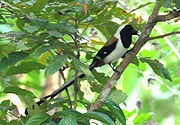
White-bellied Treepie
Encyclopedia
The White-bellied Treepie (Dendrocitta leucogastra) is a bird of the crow
family endemic to the forests of southern India. They overlap in distribution in some areas with the Rufous Treepie
but are easily to tell apart both from appearance and call.
 The white of the head and body makes it easy to distinguish from the sympatric Rufous Treepie
The white of the head and body makes it easy to distinguish from the sympatric Rufous Treepie
. This tends to be found in more dense forest and is less associated with human habitation than the Rufous Treepie.
When calling, the bird bows and droops its wings. Several birds may arrive at one tree and call repeatedly during the pre-monsoon
breeding season (mainly April–May but some nests from February). The nest is a platform of twigs on a medium sized tree. Three eggs are laid, ashy grey with green and grey blotches.
It is associated with mixed-species foraging flocks and is often found along with Greater Racket-tailed Drongo
s.
mainly south of Goa. A record from Erimalai near Dharmapuri and reports from the Surat Dangs and the southeastern Ghats of Andhra Pradesh stand outside its main distribution range. A record from central India (Chikalda, Gawilgarh) has been questioned.
Crow
Crows form the genus Corvus in the family Corvidae. Ranging in size from the relatively small pigeon-size jackdaws to the Common Raven of the Holarctic region and Thick-billed Raven of the highlands of Ethiopia, the 40 or so members of this genus occur on all temperate continents and several...
family endemic to the forests of southern India. They overlap in distribution in some areas with the Rufous Treepie
Rufous Treepie
The Rufous Treepie is an Asian treepie, a member of the Corvidae family. It is long tailed and has loud musical calls making it very conspicuous. It is found commonly in open scrub, agricultural areas, forests as well as urban gardens...
but are easily to tell apart both from appearance and call.
Description

Rufous Treepie
The Rufous Treepie is an Asian treepie, a member of the Corvidae family. It is long tailed and has loud musical calls making it very conspicuous. It is found commonly in open scrub, agricultural areas, forests as well as urban gardens...
. This tends to be found in more dense forest and is less associated with human habitation than the Rufous Treepie.
When calling, the bird bows and droops its wings. Several birds may arrive at one tree and call repeatedly during the pre-monsoon
Monsoon
Monsoon is traditionally defined as a seasonal reversing wind accompanied by corresponding changes in precipitation, but is now used to describe seasonal changes in atmospheric circulation and precipitation associated with the asymmetric heating of land and sea...
breeding season (mainly April–May but some nests from February). The nest is a platform of twigs on a medium sized tree. Three eggs are laid, ashy grey with green and grey blotches.
It is associated with mixed-species foraging flocks and is often found along with Greater Racket-tailed Drongo
Greater Racket-tailed Drongo
The Greater Racket-tailed Drongo, Dicrurus paradiseus, is a medium-sized Asian bird which is distinctive in having elongated outer tail feathers with webbing restricted to the tips. They are placed along with other drongos in the family Dicruridae...
s.
Distribution
It is found in the forests of the Western GhatsWestern Ghats
The Western Ghats, Western Ghauts or the Sahyādri is a mountain range along the western side of India. It runs north to south along the western edge of the Deccan Plateau, and separates the plateau from a narrow coastal plain along the Arabian Sea. The Western Ghats block rainfall to the Deccan...
mainly south of Goa. A record from Erimalai near Dharmapuri and reports from the Surat Dangs and the southeastern Ghats of Andhra Pradesh stand outside its main distribution range. A record from central India (Chikalda, Gawilgarh) has been questioned.

